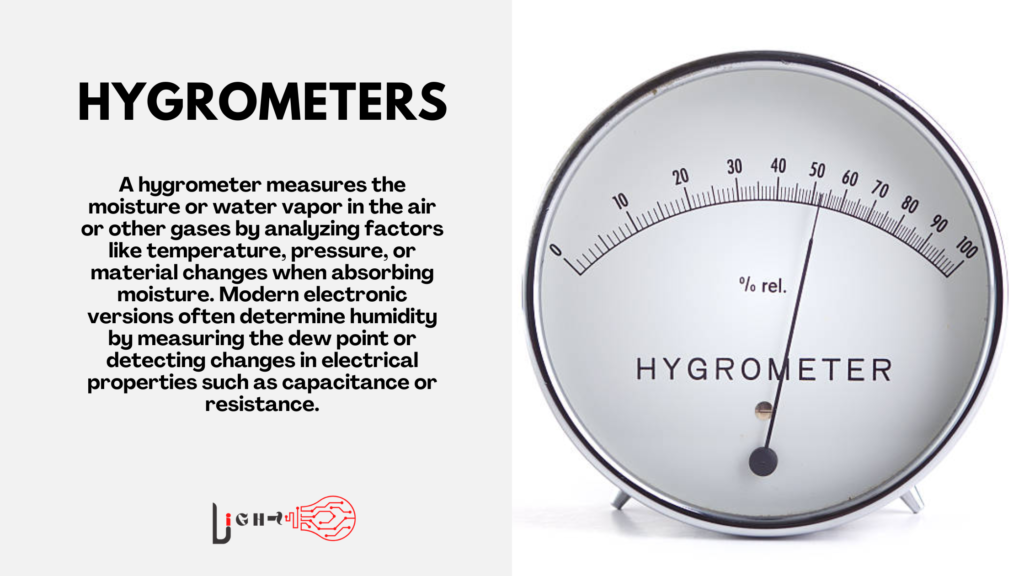A hygrometer is a tool that measures how much moisture or water vapor is in the air or another gas. Most humidity measuring tools work by checking other factors like temperature, pressure, weight, or how a material changes when it absorbs moisture. These measurements are then used to figure out the humidity level. Modern electronic hygrometers often measure the dew point (the temperature at which moisture starts to condense) or detect changes in electrical properties like capacitance or resistance to determine humidity.
What is a Hygrometer?
A hygrometer is a device designed to measure the humidity level in the air. Humidity refers to the amount of water vapor present in the air, and maintaining the right balance is essential for comfort and health. Hygrometers come in various forms, including analog and digital models. Analog hygrometers often use a needle and dial to display readings, while digital versions provide a more precise numerical display. Regardless of the type, a hygrometer helps you monitor and control humidity levels, which is particularly important in areas prone to dampness or dryness.
The Basics of Humidity Measurement
Humidity is typically expressed as a percentage, known as relative humidity (RH). The ideal indoor humidity level generally falls between 30% and 50%. Levels below this range can cause dryness and discomfort, while higher levels can lead to mold growth and other issues. Hygrometers work by sensing the moisture in the air and providing a reading that helps you understand whether your indoor environment is within the recommended range. This information allows you to take action, such as using a dehumidifier or humidifier, to maintain optimal conditions.

Types of Hygrometers
Analog vs. Digital Hygrometers
Analog hygrometers are traditional devices that measure humidity through mechanical means. These typically feature a dial with a needle that indicates the current humidity level. They are easy to use and don’t require batteries. In contrast, digital hygrometers provide more precise readings and often include additional features, such as temperature measurement and memory functions. The humidity levels are displayed on an electronic screen, which is generally easier to read. While both types have their benefits, digital hygrometers are generally favored for their accuracy.
Specialized Hygrometers for Specific Applications
Beyond standard analog and digital models, there are hygrometers specifically designed for certain applications. For instance, some hygrometers are tailored to monitor humidity in environments like cigar humidors, greenhouses, or musical instrument cases. These specialized devices often offer higher precision and may include extra features such as data logging or alert systems. Selecting the appropriate hygrometer depends on the specific environment it will be used in and the level of accuracy required.
P C Mahalanobis: The Mathematical Genius Who Revolutionized Indian Statistics!!
To know more click here:https://light.vintbit.com/general-knowledge/mahalanobis-genius-statistics/
Benefits of Using a Hygrometer in Your Home
Maintaining the right humidity level in your home is essential for both air quality and the protection of your belongings. Proper humidity levels help prevent respiratory issues, dry skin, and eye irritation, while reducing the risk of mold and dust mites, which are common allergens that can trigger asthma and allergies. Additionally, excessive humidity can lead to wood warping, paint peeling, and mold growth, damaging your home’s structure and furnishings. On the flip side, low humidity can cause wooden items to crack. Regularly monitoring humidity with a hygrometer allows you to create a healthier living environment and safeguard your home and possessions from potential damage.
How to Use and Maintain Your Hygrometer
To get the most accurate readings from your hygrometer, proper use and maintenance are essential.
Proper Placement and Calibration
Where you place your hygrometer can significantly affect its readings. It’s best to place the device in an area where you spend a lot of time, such as the living room or bedroom, away from direct sunlight, heat sources, or drafts. Calibration is also important, especially for analog models. Over time, hygrometers can become less accurate, so regular calibration is necessary to ensure reliable readings. Some digital hygrometers come with automatic calibration features, making maintenance easier.1
Tips for Accurate Readings
For the most accurate readings, keep your hygrometer clean and dust-free. Avoid placing it near windows or doors, where external conditions can influence the readings. If you notice inconsistent readings, it might be time to recalibrate or replace the device. Regularly checking the battery (for digital models) and ensuring the device is in good working condition will help maintain its accuracy over time.

